Capping off a head-turning career, Singapore's last songkok maker may be taking last orders
Songkok maker Abdul Wahab Abdullah, 65, said that wearing a traditional loose-fitting garment known as a baju kurung without an accompanying songkok was akin to "wearing a shirt without pants".
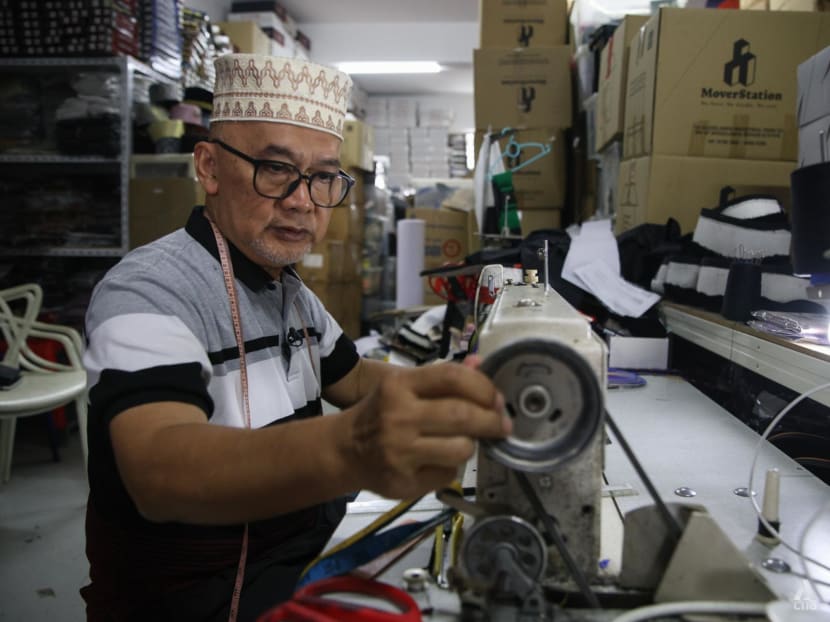
Mr Abdul Wahab Abdullah making a songkok in a warehouse on Mar 9, 2025. (Photo: ┬ķČ╣/Nuria Ling)

This audio is generated by an AI tool.
As I was wrapping up an interview with 65-year-old╠²songkok maker Abdul Wahab Abdullah and the photographer was composing a few final frames, a customer walked in along with his family.
A songkok is traditional headgear, usually made out of felt or velvet, worn by men and typically paired with the traditional Malay costume. It is most often worn on significant occasions such as Hari Raya or weddings.
We were interviewing Mr Abdul Wahab at his warehouse in an industrial building in Bedok North. For the last few months, he has not been doing business from a shop due to cost pressures.╠²
The customer, Mr Muhammad Firdaus Muhammad Hairi who had just walked in, lives in Chua Chu Kang, about halfway across the island.
Mr Firdaus could have bought an off-the-shelf songkok at a market in Bukit Gombak, just one MRT station away from his home. He could have bought one from an e-commerce platform without leaving his home.
Instead, he decided to drive 40 minutes in the rain to Mr Abdul WahabŌĆÖs warehouse, with his father, brother and son in tow.
The 38-year-old laboratory engineer said: ŌĆ£So you know how much I value his service, for me to drive all the way here just to custom order╠²a songkok.ŌĆØ╠²
Mr Firdaus was keeping up a family tradition that started decades ago when his father took him to Mr Abdul WahabŌĆÖs shop in Geylang Serai to buy a songkok.
Mr Abdul Wahab had a songkok shop in the old Geylang Serai Market before he moved to Tanjong Katong Complex in 2007.╠²
When the shopping centre closed down for major renovation work in 2023, he moved to City Plaza, another shopping complex, for just over a year before consolidating operations at his warehouse due to high rent.
When asked why his family members are regular patrons, Mr Firdaus said: ŌĆ£ItŌĆÖs his service, his advice and the quality of his work.ŌĆØ╠²
At this point, Mr Firdaus took out╠²a battered, slightly out-of-shape white box ŌĆō the same type of box containing handmade songkok that lined the shelves of Mr Abdul WahabŌĆÖs 1,100-sqf warehouse.
The box may look aged, but when he took out a songkok from inside ŌĆō black with a slight golden sheen ŌĆō it looked almost brand new.
ŌĆ£This is my wedding songkok, I custom ordered it from him about 11 years ago,ŌĆØ Mr Firdaus added.
He had brought it because he wanted to show the songkok maker and make a new one of the exact shade. Alas, Mr Abdul Wahab did not have the particular velvet in his inventory anymore.
For about half an hour, I observed how Mr Abdul Wahab attended to the needs of his customers.
He measured the circumference of their heads, listened to their preferences and let them try on songkok of different heights.
Then he showed them rolls of velvet for them to choose, offered advice on the right songkok height that best matched their faces and even which velvet colour matched their eye colour.
A round face, for instance, is better suited to a taller songkok.
At one point, Mr Abdul Wahab said this to them: ŌĆ£IŌĆÖm not very smart. IŌĆÖm just sharing what my experience has taught me.
ŌĆ£But itŌĆÖs up to your own taste and preference as well.ŌĆØ
Mr Firdaus and family readily took the advice.
After all, who else would be in a better position to advise them about songkok than Mr Abdul Wahab, who has been in the trade since he was seven years old and is widely regarded as Singapore's last songkok maker.
A SKILL HONED OUT OF NECESSITY
Mr Abdul WahabŌĆÖs lifelong journey with the songkok began with his father Abdullah Samad╠²who came to Singapore from Java in what is now Indonesia in 1917.
To earn enough income for the family, his father learned to sew from a songkok seller in Kampung Kaji, now Bussorah Street, and made a side income from this to supplement his other jobs.
ŌĆ£Of nine apprentices who learned the craft, my father was one of only two who passed,ŌĆØ Mr Abdul Wahab said.
After World War II, Mr Abdul WahabŌĆÖs father became a trishaw rider, while still making songkok and supplying them to shops to be sold.
In 1967, after his father opened his own shop at the old Geylang Serai Market, Mr Abdul Wahab, at the age of seven, began helping him there regularly and started learning to make songkok.
ŌĆ£Back in those days, it was the norm for young children to help their parents earn a living for their family,ŌĆØ Mr Abdul Wahab said.
ŌĆ£At age five or six, I was already helping my mum peddle kueh╠²(sweet or savoury cakes)╠²around the neighbourhood.ŌĆØ
For years, Mr Abdul Wahab would head straight from school to his fatherŌĆÖs shop, going home only when his father did so at night.
When his mother opened a hawker stall in 1971, he would first help at the stall before going to school and then head to the songkok shop after that.
Mr Abdul Wahab was the eighth of 11 siblings, but he was his father's only apprentice, he said.
This was in part due to him being the closest to his father, but also a reflection of just how much dedication is needed to master the craft, a level of commitment his siblings lacked, he added.
ŌĆ£Learning to make songkok needs a lot of patience and perseverance. Not everyone can fully commit to that,ŌĆØ he said in Malay.
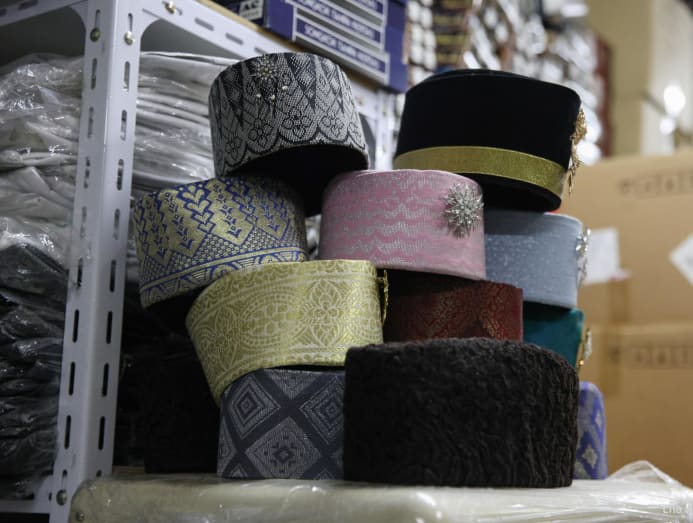
For Mr Abdul Wahab himself, it took four years before he was entrusted at the age of 11 to make a songkok on his own.
ŌĆ£There was this sense of satisfaction and pride, looking at the product of my own handiwork,ŌĆØ he recalled.
Mr Abdul WahabŌĆÖs voice began to crack at some points when talking about his father.
As a businessman, his father was very friendly and approachable, he recalled. As a father, his old man was firm, but hardly fierce.
ŌĆ£Whenever I made a mistake, he never scolded me,ŌĆØ Mr Abdul Wahab said.
ŌĆ£HeŌĆÖd simply remind me, ŌĆśUndo the stitch, redo it the correct way. Else you might carry on the bad habit even until you have your own shop'.ŌĆØ
As a homage to his father, Mr Abdul Wahab picked a trishaw as the brand image for his handmade songkok.
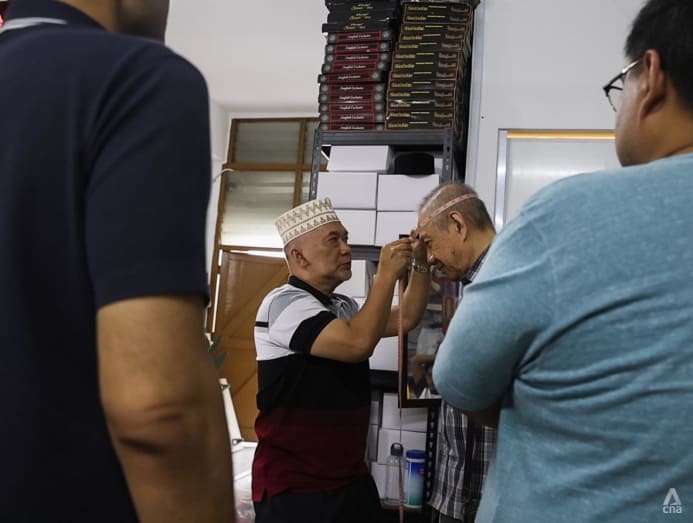
HEADGEAR FOR FAMILIES AND ROYALTY
Mr Abdul Wahab has known no other way of earning a living other than entrepreneurship. He also helped to run his mother's hawker stall in Chai Chee.
It was not that he had avoided taking up other jobs.
After finishing his full-time National Service, he asked his fatherŌĆÖs blessings to stop working at the songkok store and to seek work elsewhere. Instead, he was handed an ultimatum.
ŌĆ£He told me, ŌĆśIf you choose to work outside, donŌĆÖt step foot in this shop ever again'.ŌĆØ
It sounded harsh, but his father later explained that he did not want his son ŌĆ£to be stepped onŌĆØ by employers and be subjected to the harsh working conditions he had faced.
ŌĆ£He told me, ŌĆśYou donŌĆÖt know what itŌĆÖs like working outside, I do. I donŌĆÖt want you to be like me'.ŌĆØ
Mr Abdul Wahab did not take his fatherŌĆÖs response badly. He told me that he had always been interested in continuing his fatherŌĆÖs legacy and that episode merely nudged him more strongly down that path.
ŌĆ£I knew that I really wanted his knowledge (in the craft). Knowledge cannot be bought or traded. It can only be learned from a teacher."
Back in the 1960s, there were quite a number of songkok makers, Mr Abdul Wahab said. "But most of the time, their children did not learn the skills from them.
ŌĆ£I had resolved that one day, I would take over from my father.ŌĆØ
Since then, he has never looked back.
When he had a shop, Mr Abdul Wahab would sew about 2,000 pieces of songkok on average a year, he said.╠²
The peak period would be during the month of Ramadan, when people order the traditional headgear to wear for Hari Raya Aidilfitri.
ŌĆ£This receipt booklet has 100 pages. During Ramadan, IŌĆÖll finish two booklets,ŌĆØ he said, pointing to a booklet of handwritten receipts next to his industrial-grade sewing machine.
ŌĆ£And each page might not be just one personŌĆÖs order, itŌĆÖs for the family. So one receipt may have two, three or maybe four songkok orders.ŌĆØ
Outside of the festive seasons, Mr Abdul Wahab also receives orders for special occasions such as weddings.
He recalled getting a call from a customer a few years ago just as he was about to close his shop for the day at Tanjong Katong Complex. The customer, who was from Chua Chu Kang, told him to wait because he really wanted to make a songkok urgently.
ŌĆ£As it turned out, he told me that he had ordered a custom songkok from me in the 1990s at my shop in Geylang Serai market. Now, it was his sonŌĆÖs turn to get married so as the father of the groom, he wanted to look sharp and make a new one.ŌĆØ╠²
Another memorable episode happened in his early years at Tanjong Katong Complex.
ŌĆ£A customer walked in and ordered a songkok on behalf of a member of a royal family in Kalimantan,ŌĆØ he said.
When I asked if he felt nervous then, he replied: ŌĆ£Nah, IŌĆÖve been doing this for years already.ŌĆØ
He admitted, though, that business was a lot more brisk when he had retail space in a shopping complex, where customers may also buy his ready-made songkok ŌĆō either those that he had sewn himself or that he imported from Indonesia for the more budget-conscious.
He sells the songkok he imports for about S$20. His hand-sewn ones go for upwards of S$60.
Besides the lack of foot traffic, online competition as well as the growing number of Singaporeans who shop in Malaysia for their festive needs have caused a dent in his business, too.
A few years ago, his youngest son began helping him market his business online through his own website and on social media accounts. This has brought him a steady flow of customers, albeit fewer than in the years before.
ŌĆ£Back then, it was the older shoppers of Tanjong Katong Complex who would take their family to my shop,ŌĆØ he said.
ŌĆ£These days, itŌĆÖs more of the younger generation who searched online, found my warehouse address and brought their family along.ŌĆØ
When ┬ķČ╣ TODAY met him on the first weekend of Ramadan, he had an average of three or four appointments with customers daily.
And each year, more orders will come in as Hari Raya Aidilfitri draws nearer.
As I was writing this piece, Mr Abdul Wahab had already stopped taking new orders for this Hari Raya, which falls on March 31.
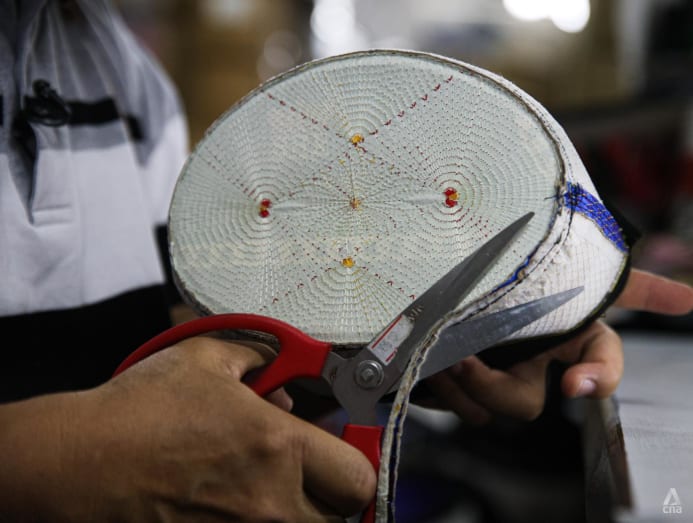
SONGKOK WEARERS OVER THE GENERATIONS
One upside of marketing his service online is that he has received orders from many countries, including Japan, Nigeria and the United Kingdom.
He was not sure who these buyers were, but he noted that postage for one of the orders cost more than the songkok itself.
Most of the time, the orders are still made by customers in Singapore, especially long-time regulars.
ŌĆ£Many were my fatherŌĆÖs customers first. Then their sons, their grandchildren (followed suit),ŌĆØ he said.
I remember that as a child, I had observed that the songkok was commonly worn during Hari Raya and it almost felt compulsory to do so.╠²
I have been scolded many times by my parents for not wearing one whenever I dressed up in my traditional clothes ŌĆō even today, as a 35-year-old man.╠²
Looking around the wider community these days, it is not uncommon to see Malay men in traditional wear without their headgear. Even online advertisements marketing Hari Raya clothes now show models without the songkok.
Mr Abdul Wahab acknowledged that he has seen a number of youngsters over the years who no longer put on their songkok. Whenever he could, he would try to gently advise them.
ŌĆ£IŌĆÖd tell them, 'If you donŌĆÖt wear songkok now, your children will look at you and follow suit. And in the future, who else will be wearing our traditional headgear?ŌĆÖŌĆØ╠²
However, Mr Abdul Wahab is still quietly confident about the future of songkok wearers here, saying that the vast majority of the Malays in Singapore still make it a point to wear the ŌĆ£complete setŌĆØ whenever they don their traditional wear on special occasions: Baju kurung, kain sampin (a type of sarong), capal (traditional sandal) and songkok.
ŌĆ£Wearing baju kurung without songkok is like wearing a shirt without pants,ŌĆØ he quipped, triggering my traumatic memories of being scolded by my mother for forgetting my songkok.
Mr Abdul Wahab continued: ŌĆ£The ones who wear it, theyŌĆÖre still plenty. But itŌĆÖs the ones who make it, that is dwindling in number.ŌĆØ
This then brought me to the most important question for him: Does he feel the pressure to impart his knowledge and skills to the future generation, especially to his own three children?
ŌĆ£No. To me, God has arranged everything. If it is His will that my children continue my craft, then IŌĆÖd be grateful,ŌĆØ he said.
ŌĆ£We can influence them, sure, but we cannot force them.ŌĆØ
I asked him why he takes such a relatively soft stance, unlike his father. His reply was that times have changed.
ŌĆ£Now is not the time for forceful parenting ŌĆ” As a parent, our role is to be supportive.ŌĆØ
A demonstration of this was when his daughter, a former flight stewardess with no experience in business, decided out of the blue to operate a food stall at a school.
Despite the initial protestations from himself and his wife, they decided to still help her in her endeavour.╠²
Mr Abdul WahabŌĆÖs wife helps at the stall daily. Before he met me for the interview, he had just returned from the market to buy some supplies for the stall.
ŌĆ£If we as parents donŌĆÖt show support, how can we expect our children to succeed?ŌĆØ
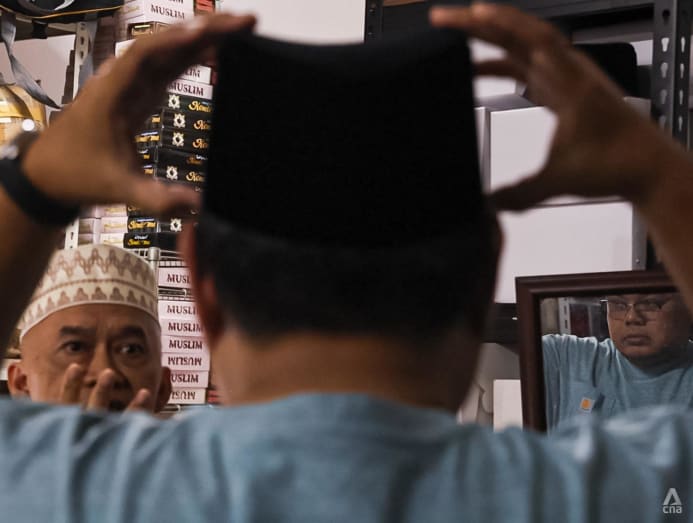
As for the fate of his own business, he said that his three children have always been his helpers since they were young, especially during the peak period of Ramadan.
They all can sew, but at ŌĆ£around 70 per centŌĆØ proficiency of the standard that he expects of a songkok craftsman.
Of the three children ŌĆō aged 38 to 42 ŌĆō his youngest son has shown the most interest in taking over his business, even though he has a career in the police force.
ŌĆ£I told him that he has a stable career and a family, so focus on them first. When he has free time over the weekend, he can continue learning. Maybe do this full-time when he has retired.ŌĆØ
Mr Abdul Wahab admitted that both he and his wife contemplated retirement after he closed his shop in City Plaza.
ŌĆ£But I told my wife, the best I can do is semi-retirement. The community still needs me to sew songkok for them.ŌĆØ













